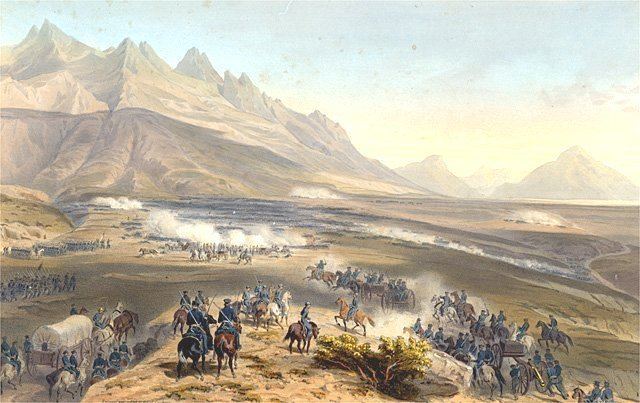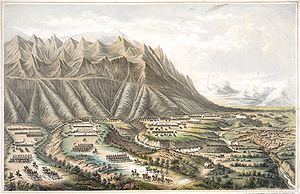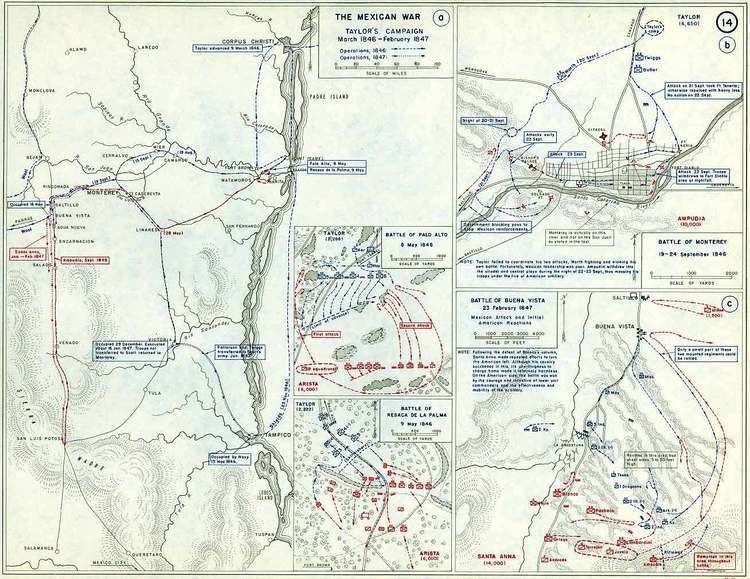4,594 or 4,750 15,142 | Date 23 February 1847 | |
 | ||
267 killed387 wounded6 missing 591 killed1,048 wounded1,894 missing Similar Mexican–American War, Battle of Monterrey, Battle of Cerro Gordo, Battle of Palo Alto, Battle of Resaca de la Palma | ||
Battle of buena vista february 23 1847 mexican american war
The Battle of Buena Vista (February 22 – February 23, 1847), also known as the Battle of Angostura, saw the United States Army use artillery to repulse the much larger Mexican Army in the Mexican–American War. Buena Vista, a village in the state of Coahuila, is seven miles (12 km) south of Saltillo, in Mexico.
Contents
- Battle of buena vista february 23 1847 mexican american war
- Forgotten transcendence the battle of buena vista 1847 dr gregory hospodor
- Background
- Battle
- Aftermath
- References

Forgotten transcendence the battle of buena vista 1847 dr gregory hospodor
Background

After the Battle of Monterrey and the end of the armistice, Major General Zachary Taylor's Army of Occupation with Brigadier General William J. Worth's 1,000 men advanced onto undefended Saltillo on November 16, despite orders to halt any movement further south, considering it strategic to cover the approaches to Monterrey and Parras de la Fuente. Taylor then directed General John E. Wool from Monclova to Parras, the objective being control of that agricultural area. Wool's force moved to Agua Nueva, south of Saltillo, on December 21, to counter rumors of impending attack.

In mid-August 1846 Antonio López de Santa Anna returned from exile and quickly assumed command of the Mexican army, abandoning any pretense of reconciling with the US. He reached San Luis Potosí on Oct 8 with a force of 25,000 men. In early January, Santa Anna acquired a letter from Gen. Winfield Scott ordering Worth's troops to join General David E. Twiggs' and General John A. Quitman's division's in Veracruz, prompting Santa Anna to make attack plans for Saltillo. General José de Urrea's cavalry would simultaneously retake Ciudad Victoria and cut off Monterrey from Matamoros, Tamaulipas. Santa Anna's army departed San Luis Potosí on Jan 27 with 21,553 men, and reached Encarnacion, south of Saltillo, with 15,142 men on Feb. 20.

Taylor moved 4,650 of his men to Agua Nueva on February 14, but on February 20, Maj. Benjamin McCulloch's Texas Rangers encountered Santa Anna's force at Encarnacion, prompting Taylor's withdrawal to Angostura, a mile and a quarter south of Hacienda San Juan de la Buena Vista. Gen. Wool was charged with selecting "the field of battle" and making "such dispositions of the troops on the arrival of the enemy" as he deemed necessary.

Wool thought the site excellent for defense since the road passed through a narrow valley here, which was crossed at right angles by several ravines east of the road and arroyos were to the west. Wool placed Capt. John M. Washington's battery across the road, supported by the 1st Illinois under Col. John J. Hardin and 2nd Kentucky under Col. William R. McKee. Continuing to the left was the 2nd Illinois under Col. William H. Bissell, General Joseph Lane's Indiana Brigade, the Kentucky and Arkansas horsemen, with two squadrons of dragoons and a company of Texans in reserve.
Santa Anna advanced to Carnero Pass below Agua Nueva on February 21 and on February 22, demanded a surrender, to which, Taylor's aide, William Wallace Smith Bliss, eloquently replied, "I beg leave to say that I decline acceding to your request." Santa Anna's forces consisted of Major General Manuel María Lombardini's division and Major General Francisco Pacheco's division in the center with fourteen pieces of artillery, Col. Santiago Blanco's Regiment of Engineers and three 16-pounders on the left, and Major General Pedro de Ampudia's light infantry with General Julian Juvera's strong cavalry brigade on the right with two batteries. In reserve was Major General Jose Maria Ortega's infantry division and Brigadier General Francisco Mejia's brigade.
Battle
Santa Anna began the attack with a feint by Mejia to the American right, but his main thrust was to the American left. Wool moved three companies of Kentucky cavalry under Col. Humphrey Marshall and four rifle companies of the Arkansas regiment under Col. John S. Roane and four companies of Hoosiers under Major Willis A. Gorman to strengthen his left. Marshall's and Ampudia's men skirmished by 3:30 PM but darkness brought an end to the fighting.
After dark, Taylor, escorted by the Mississippi Rifles, Col. Jefferson Davis, and Charles A. May's dragoons, checked on the Saltillo garrison, but returned by 9 AM on the morning of February 23. During the night, Brigadier General Manuel Micheltorena moved five 8-pounders above the American left, intending to flank them along the high ground the next morning at daylight.
Ampudia's brigade started the assault, supported by Lombardini's and Pacheco's divisions, while Moras demonstrated against the American right. The 2nd Indiana faced a force of 7,000 Mexicans, prompting Wool to send the 2nd Illinois and Capt. Thomas W. Sherman's battery in support.
The Hoosiers, after taking ninety casualties, broke and fled, forcing the 2nd Illinois in a slow fighting withdrawal, and Marshall's men to flee northward to the Buena Vista hacienda. Juvera's cavalry was able to turn the American left flank and head for Buena Vista.
Davis' Mississippians were ordered to shield Buena Vista along with the Arkansas and Kentucky cavalry, the 3rd Indiana, and Capt. Enoch Steen's dragoons. The American left was thus strengthened, the center still held and the right was still solid.
At the hacienda, Archibald Yell's men held, although he was killed, and Steen's dragoons were able to split Juvera's column, forcing the advance portion past the hacienda and under fire from Sherman's battery, while the dragoons threw the rest into confusion. Davis' men then sent the Mexicans fleeing, although Davis was wounded in the heel.
Major John Munroe organized the defense of the hacienda proper, using the 2nd Indiana, from Juvera's attacks, while the Mississippians and the 3d Indiana were organized into a large "V", forced Juvera's about 2,000 survivors into a ravine. A young Mexican lieutenant, Jose Maria Montoya, tricked Taylor into a ceasefire, allowing the trapped Mexicans enough time to escape. Brigadier José Vicente Miñón appeared before Saltillo but retreated to the southwest.
Santa Anna renewed an attack on the main U.S. position led by Gen. Francisco Pérez with artillery support. They were met at 5 PM by fire from O'Brien's and Thomas' guns and two Illinois and a Kentucky regiment under Col. John J. Hardin in which he was killed.
An artillery battery under Cpt. Braxton Bragg then arrived with orders to "maintain the position at all costs". Taylor rode over to Bragg, and after a brief conversation in which Bragg replied he was using single canister shot, Taylor ordered "double-shot your guns and give 'em hell, Bragg". Later this order, although misquoted as "give them a little more grape, Captain Bragg", would be used as a campaign slogan which carried Taylor into the White House. Pérez's attack was repulsed and the fighting ended as heavy rain fell over the field.
Aftermath
On February 25, Santa Anna's council of war at Agua Nueva advised retreat. Taylor led his army back to Nueva; he did not pursue Santa Anna any further south.
Buena Vista County, Iowa, in 1859, was named in honor of the battle, as was Buena Vista Township, in Michigan's Saginaw County, and the cities of Buena Vista, Virginia, Buena Vista Oregon, Buena Vista, New Jersey, and Buena Vista, Alabama, in northern Monroe County.
Among the dead was Henry Clay Jr., second son of American statesman Henry Clay, a vociferous opponent of the Mexican War. His death was the subject of prints by Currier & Ives, and Neale & Pate. Also killed were Archibald Yell, former governor of Arkansas, and John J. Hardin of Illinois, a Whig political rival of Abraham Lincoln.
